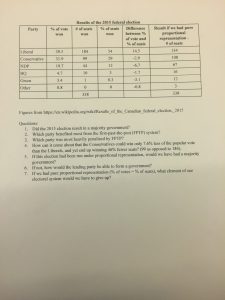

Contribute
If you want to add yourself to this blog, please log in.
Categories
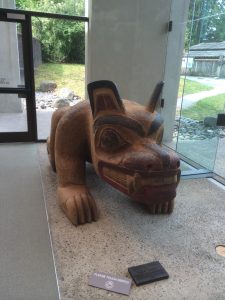
A boy’s walked past old trees as he neared his friend, Bear. Bear’s hind-legs were folded tight under his haunches, his forelegs pressing into the earth, as if the world were rising up from beneath him, and he had to push it down.
Boy walked up beside his friend, who stared straight ahead, motionless. Bear’s teeth were showing, each as thick as a human shin bone.
Hello, Bear.
Hll’llow.
May I stroke your neck?
Y’caan. Buchr g’nna loozyr haand.
Would you bit me?
Bear’s teeth shifted.
Why would you bite me?
The boy look at into Bear’s big, black eyes. They were perfect saucers, unknowable. The boy saw Bear’s struggle in his muscles, their tension translated into the rough grain of Bear’s fur. But the eyes were still. They were reflections of darkness on a lake where all the stars were hiding and the moon was new.
Bear spoke.
Because I am a bear, and sometimes, bears bite.
He moved his head away from the boy and his eyes fixed forward. The trees were pressing in, their greens and browns growing darker with each passing moment.
Boy stood next to his friend for a few moments longer, his hand moving a little as he stared at Bear’s neck. Finally, he bowed his head and turned to leave, the trees pressing in, and the sound of Bear’s hot breath fading away as the boy walked on.
MOA Experience- Brooke 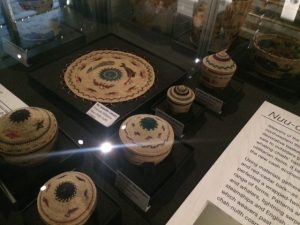
My experience at the MOA was quite fascinating. With business education being my subject area, there are many ways that I am able to incorporate aboriginal culture within my classroom. These baskets are one of the many cultural pieces that were traded or sold to develop and increase the aboriginal economy. I also found it fascinating that the women of this community were heavily involved within the production of the basket weaving- they were actually predominately produced by women. It got substantially harder to create their baskets because of the specific land restrictions which, forced the women to go further and further outside of their community to gather their materials to for production. This in turn makes it considerably more difficult for these women to run their business. We have discussed in our class how Aboriginal people’s may not have traded their product for profit rather they traded their baskets (or food) simply to meet their needs and possibly increase their status within their community therefore, not having easy access to materials would alter their production and jeopardize their status within their community.

The mask is a cover, which has two sides front and the back. The front cover is something how you want to show yourself to the world and create your personality that you want the world to see you as. Behind the cover is you and yourself, a personality that you can’t change the person that talks to your own soul. Makes the decision with angel and the demon in the head and in heart. The mask is a cover that is shown to the world – the person who is wearing the mask can see the world with his real eyes but the world can’t see the real person. It allows to gain the power and strength to possess any kind of personality they want but at the same time a weakness for not able to show their actual face to the world. It also shows cowardliness of a person to hide behind the mask.
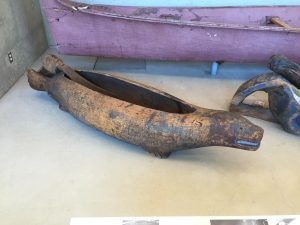
Kukwalit (A house dish), Beaver
We call ourselves the Lawitsis people on Turnour island. When we were growing up, I remember helping mother prepare food for the potlatch. We had prepared a large quantity of fish with herbs from the meadow and cooked it slowly on the fire. When ready, we would transfer the food to the Lukwalit or house dish and bring it to the people. The food would stay warm for hours and give a lovely aroma to the whole house. I loved the way we would all sit around it and wait for our turn to be served while listening for stories and playing games. The huge spoon looked so heavy! I remember being so hungry and staring at the intricate carvings. Each house dish represented an animal and was painted with bright colours. Ours was a beaver. Once I watched an artist make a Lukwalit and realized that it is made out of one cedar block!
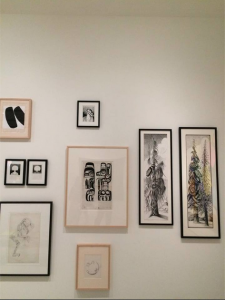
The best part of being an English/Theatre major is the freedom and creativity in interpretation. When I saw this collection of framed works I immediately thought of being in a home. A place where art is celebrated and appreciated. A place where a photo or painting is more than a drawing but instead it represents a family. Anyways, here is the monologue/creative writing thing that was inspired from the photo above … (Interpret it how you will.)
Sitting beside a crackling wood stove; I stare in astonishment at the history that lines of the walls of my grandmother’s home. A museum where my families history is the main exhibit. Walls dripping with images, fabrics, scents that define who I am and who our family is. The most appetizing Sunday is spent here. Curled up with a novel, soft music adding to the atmosphere and a purring kitten at the tip of your toes. My grandmother sits across from me. She is smiling. I can see from the beautiful cracks in her porcelain skin; that she has lived a admirable life. She is the tree that roots our family and her home is our shelter.
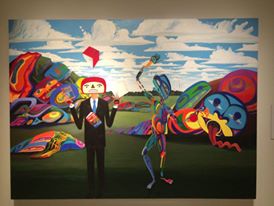
I chose to use an image from the Lawrence Paul Yuxweluptun: Unceded Territories exhibit. The exhibition had pieces from over thirty years of his work. All of the paintings were bright, powerful and vivid. I chose to use one of his paintings because he uses art as a mean to create political action. I connect to the idea of art and change because of my background in Applied Theatre. Yuxweluptun will paint what he sees, and with the Theatre I have created in the past it was often stemmed from my personal experiences. In the piece An Indian Game (Juggling Books), one can see a aboriginal character dressed in a business suit juggling the idea of truth and policy in the form of a book. The man beside him however is not wearing a suite and matches the land and colors behind him. This contrast is very powerful. The image of juggling the books reminds me of how I feel as a teacher candidate and incorporating aboriginal studies into the classroom. It is a new subject and one that I want to approach appropriately and truthfully. However, I am still unsure of what form and where I will use it in the classroom. After visiting the museum I was inspired and hope to use storytelling and my experiences and my students as an avenue to integrate a more holistic way of teaching my classroom.
Jillian O’Quinn

For the assignment I chose to teach Christine six different types of stages found in Theaters across the globe. The picture above is what the cheat sheet I used and the photo below is one of the six pages I had used on my practicum. The worksheet I used to teach her was from my practicum school and used to teach grade 8 drama students. My cheat sheet for Christine consisted of simple drawings condensed onto one page so that she could use while drawing on the board in front of our group. The picture is key while teaching this to students so they understand the audiences relation to the stage. Christine did a wonderful job re teaching and answering questions from the group. She was confident and was even able to use humor while teaching. She also used the visual aid to help answer the questions. The only thing I forgot to mention to her was the order of the creation of stages and where they could be found around the world, but that was due to the time restraint
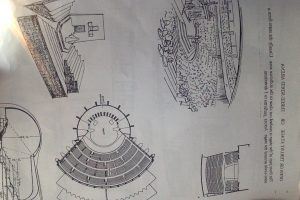 .
.
Attached is my visual aid to help students understand the importance of budgeting.
Ryan: Ryan started off his 5 minute teach out being extremely enthusiastic. His voice was clear and his tone of voice was great. I really liked how he took my lesson and put his own spin on certain things. He was able to improvise some of the ideas in a clear and concise way.
There are many interesting art work in the Museum of Anthropology. As a future math teacher, I think that these exhibits can be used in math class as a device to motivate our students and to let them see that math is actually all around us from past to present. Instead of giving random math examples, implementing art work in MOA into the course is good for them to discover the beauty of math and to learn about other cultures.

For example, the Brentwood box is used in Aboriginal people’s daily life. The question then for the students will be: how much wood (in square units) is needed to make this box; how much rice can this box contain (the volume)?
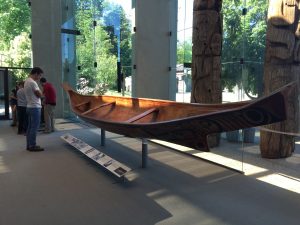
Given the length of this canoe, the distance between two sides of a river, and the start and end time, students can be asked to find the velocity of them crossing the river.
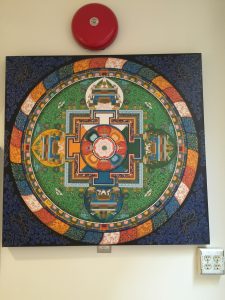
We can also let the students to calculate the area of the shapes in this painting. And amount of paint for each color needed (given the amount needed for each square unit) to finish this piece of work.
There are so many more examples! Math is from the life.